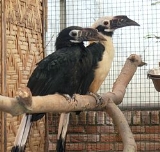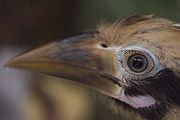
Tarictic Hornbill
Encyclopedia
The Tarictic Hornbill is a hornbill
found in rainforest
s on the islands of Panay
, Negros, Masbate
, and Guimaras
, and formerly Ticao, in the Philippines
. It formerly included all other Philippine tarictic hornbill
s as subspecies
, in which case the common name
of the 'combined species' was shortened to Tarictic Hornbill.
. The male has a creamy-white head and neck, a white upper chest, a reddish brown lower chest and uppertail-coverts
, and a creamy-white buff tail with a broad black tip. The bill and casque are blackish; the former with yellowish ridges. The bare ocular skin is pinkish-white. The tail and bill of the female resemble that of the male, but otherwise the plumage
of the female is black, and the ocular skin is blue.
The principal food of Visayan Tarictic Hornbill is fruit. It also eats insect
s, beetle
s, ant
s and earthworm
s (rarely).
 This is a highly endangered species. The total population is estimated at 1800 individuals. There has been a heavy decline in population due to hunting
This is a highly endangered species. The total population is estimated at 1800 individuals. There has been a heavy decline in population due to hunting
and loss of habitat caused by deforestation
. The subspecies ticaensis was described as "abundant" in 1905, but almost the entire forest on the island was replaced by plantations and settlements in the 20th century. The last time the Ticao Tarictic was seen was in 1971, and it is now likely to be extinct. If confirmed, this is the first taxon
of hornbill to go extinct in recorded history; many other taxa in the family are now at risk.
, England. There are two pairs at Chester, and two pairs at Avifauna in the Netherlands.
In the past, Los Angeles Zoo
has bred this species, but it is not known whether these birds were pure Penelopides panini panini, so it may not be the first captive breeding of this species; that title may go to a breeding centre on Panay, where Chester's birds came from. Chester zoo have bred this species.
Hornbill
Hornbills are a family of bird found in tropical and subtropical Africa, Asia and Melanesia. They are characterized by a long, down-curved bill which is frequently brightly-colored and sometimes has a casque on the upper mandible. Both the common English and the scientific name of the family...
found in rainforest
Rainforest
Rainforests are forests characterized by high rainfall, with definitions based on a minimum normal annual rainfall of 1750-2000 mm...
s on the islands of Panay
Panay Island
Panay is an island in the Philippines located in the western part of the Visayas. Politically, it is divided into five provinces: Aklan, Antique, Capiz, and Iloilo, all in the Western Visayas Region. It is located southeast of the island of Mindoro and northwest of Negros, separated by the...
, Negros, Masbate
Masbate
Masbate is an island province of the Philippines located in the Bicol Region. Its capital is Masbate City and consists of three major islands: Masbate, Ticao and Burias.-History:...
, and Guimaras
Guimaras
Guimaras is an island province of the Philippines located in the Western Visayas region. Among the smallest provinces, its capital is Jordan. The island is located in the Panay Gulf, between the islands of Panay and Negros...
, and formerly Ticao, in the Philippines
Philippines
The Philippines , officially known as the Republic of the Philippines , is a country in Southeast Asia in the western Pacific Ocean. To its north across the Luzon Strait lies Taiwan. West across the South China Sea sits Vietnam...
. It formerly included all other Philippine tarictic hornbill
Tarictic Hornbill
The Tarictic Hornbill is a hornbill found in rainforests on the islands of Panay, Negros, Masbate, and Guimaras, and formerly Ticao, in the Philippines...
s as subspecies
Subspecies
Subspecies in biological classification, is either a taxonomic rank subordinate to species, ora taxonomic unit in that rank . A subspecies cannot be recognized in isolation: a species will either be recognized as having no subspecies at all or two or more, never just one...
, in which case the common name
Common name
A common name of a taxon or organism is a name in general use within a community; it is often contrasted with the scientific name for the same organism...
of the 'combined species' was shortened to Tarictic Hornbill.
Description
The adults show sexual dimorphismSexual dimorphism
Sexual dimorphism is a phenotypic difference between males and females of the same species. Examples of such differences include differences in morphology, ornamentation, and behavior.-Examples:-Ornamentation / coloration:...
. The male has a creamy-white head and neck, a white upper chest, a reddish brown lower chest and uppertail-coverts
Covert (feather)
A covert feather on a bird is one of a set of feathers, called coverts, which as the name implies, cover other feathers. The coverts help to smooth airflow over the wings and tail.- Wing-coverts :...
, and a creamy-white buff tail with a broad black tip. The bill and casque are blackish; the former with yellowish ridges. The bare ocular skin is pinkish-white. The tail and bill of the female resemble that of the male, but otherwise the plumage
Plumage
Plumage refers both to the layer of feathers that cover a bird and the pattern, colour, and arrangement of those feathers. The pattern and colours of plumage vary between species and subspecies and can also vary between different age classes, sexes, and season. Within species there can also be a...
of the female is black, and the ocular skin is blue.
Diet and behavior
Visayan Tarictic Hornbills live in groups and frequent the canopy of rainforests. These birds are noisy and emit an incessant sound that sounds like ta-rik-tik, hence the name. Despite their noise they are difficult to find, being well camouflaged by the dense foliage.The principal food of Visayan Tarictic Hornbill is fruit. It also eats insect
Insect
Insects are a class of living creatures within the arthropods that have a chitinous exoskeleton, a three-part body , three pairs of jointed legs, compound eyes, and two antennae...
s, beetle
Beetle
Coleoptera is an order of insects commonly called beetles. The word "coleoptera" is from the Greek , koleos, "sheath"; and , pteron, "wing", thus "sheathed wing". Coleoptera contains more species than any other order, constituting almost 25% of all known life-forms...
s, ant
Ant
Ants are social insects of the family Formicidae and, along with the related wasps and bees, belong to the order Hymenoptera. Ants evolved from wasp-like ancestors in the mid-Cretaceous period between 110 and 130 million years ago and diversified after the rise of flowering plants. More than...
s and earthworm
Earthworm
Earthworm is the common name for the largest members of Oligochaeta in the phylum Annelida. In classical systems they were placed in the order Opisthopora, on the basis of the male pores opening posterior to the female pores, even though the internal male segments are anterior to the female...
s (rarely).
Subspecies
- Visayan Tarictic Hornbill, Penelopides panini panini - PanayPanay IslandPanay is an island in the Philippines located in the western part of the Visayas. Politically, it is divided into five provinces: Aklan, Antique, Capiz, and Iloilo, all in the Western Visayas Region. It is located southeast of the island of Mindoro and northwest of Negros, separated by the...
, Negros, MasbateMasbateMasbate is an island province of the Philippines located in the Bicol Region. Its capital is Masbate City and consists of three major islands: Masbate, Ticao and Burias.-History:...
and GuimarasGuimarasGuimaras is an island province of the Philippines located in the Western Visayas region. Among the smallest provinces, its capital is Jordan. The island is located in the Panay Gulf, between the islands of Panay and Negros...
. - Ticao Tarictic Hornbill, Penelopides panini ticaensis - Ticao (likely extinct).
Conservation

Hunting
Hunting is the practice of pursuing any living thing, usually wildlife, for food, recreation, or trade. In present-day use, the term refers to lawful hunting, as distinguished from poaching, which is the killing, trapping or capture of the hunted species contrary to applicable law...
and loss of habitat caused by deforestation
Deforestation
Deforestation is the removal of a forest or stand of trees where the land is thereafter converted to a nonforest use. Examples of deforestation include conversion of forestland to farms, ranches, or urban use....
. The subspecies ticaensis was described as "abundant" in 1905, but almost the entire forest on the island was replaced by plantations and settlements in the 20th century. The last time the Ticao Tarictic was seen was in 1971, and it is now likely to be extinct. If confirmed, this is the first taxon
Taxon
|thumb|270px|[[African elephants]] form a widely-accepted taxon, the [[genus]] LoxodontaA taxon is a group of organisms, which a taxonomist adjudges to be a unit. Usually a taxon is given a name and a rank, although neither is a requirement...
of hornbill to go extinct in recorded history; many other taxa in the family are now at risk.
Captivity
This species has just been imported from Panay in the Philippines by Chester ZooChester Zoo
Chester Zoo is a zoological garden at Upton-by-Chester, in Cheshire, England. It was opened in 1931 by George Mottershead and his family, who used as a basis some animals reported to have come from an earlier zoo in Shavington. It is one of the UK's largest zoos at...
, England. There are two pairs at Chester, and two pairs at Avifauna in the Netherlands.
In the past, Los Angeles Zoo
Los Angeles Zoo
The Los Angeles Zoo , is a zoo founded in 1966 and located in Los Angeles, California. The City of Los Angeles owns the entire zoo, its land and facilities, and the animals...
has bred this species, but it is not known whether these birds were pure Penelopides panini panini, so it may not be the first captive breeding of this species; that title may go to a breeding centre on Panay, where Chester's birds came from. Chester zoo have bred this species.

